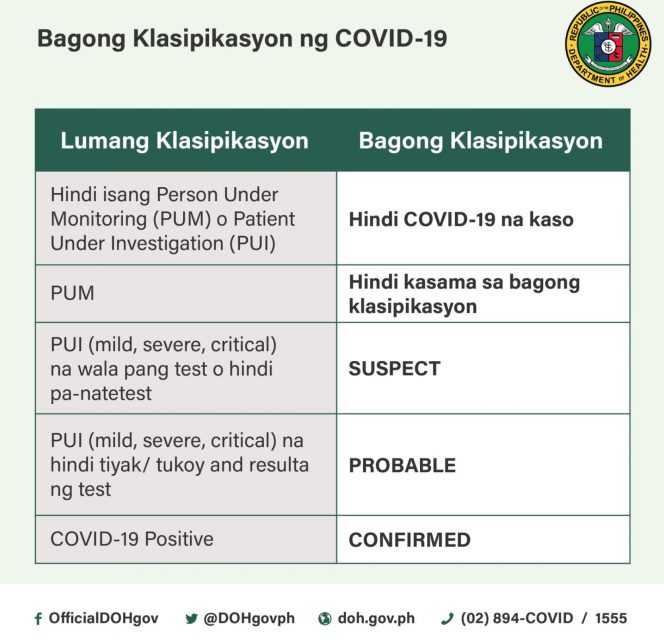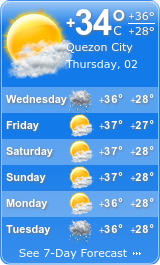
(Eagle News) – The Department of Health has changed its classification on COVID-19 cases.
Coronavirus cases are now classified as probable, suspect and confirmed cases, according to DOH Administrative Order 2020-0013 signed on April 9 by Health Secretary Francisco Duque III.
The new classification and order was effective immediately.
Before this, the DOH classified individuals possibly exposed to COVID-19 cases as persons under monitoring (PUMs), while those already exhibiting coronavirus symptoms were listed as persons under investigation (PUIs). Those who have already tested positive were classified as COVID-19 confirmed cases.
Under the new grouping, PUMs are no longer included in the classification, the DOH said.
“Because of evidence of local community transmission in the country, its residents are assumed to have been exposed to the infection,” the DOH explained
Meanwhile, all PUIs – mild, severe or critical – who were not tested or are awaiting test results are already classified as “suspect” cases. Under the new rules, all health workers with cough, fever and shortness of breath, or other respiratory symptoms, are considered as suspect cases.
On the other hand, the PUIs – whether mild, severe, or critical – “with inconclusive test results are classified as “probable” COVID-19 cases.
Those with COVID-19 positive test results are classified as “confirmed” COVID-19 cases, the DOH said.
The DOH said that it had to shift the classification due to recent development in the country’s COVID-19 situation where more local transmission of cases are being reported daily in surges.
“The country is also challenged on how to cope with the sudden surge of confirmed cases and must identify measures to ensure that the health system will capably respond to this emergency to reduce the number of serious and critically ill cases and fatalities while maintaining essential and other routine health services,” the DOH’s recent order explained.
-Clearer system of COVID-19 case detection and reporting for all health facitlities –
The new DOH order also sets a “standard for and system of case detection, investigation, laboratory confirmation, and notification.”
Under the order, health facilities in the country will monitor Severe Acute Respiratory Infections (SARI) and Influenza-like Illnesses (ILI) and promptly report these to the DOH.
They will particularly take note of clustering of such cases –SARI and ILI – and deaths of unknown etiology or origin.
The DOH also further clarified what it considers as a “close contact” for purposes of effective contact tracing amid the current pandemic.
-Close contact further defined-
A close contact is defined as any of the following:
-a person without proper personal protective equipment (PPE) who is providing direct care for a confirmed COVID-19 case;
-a person who had direct physical contact, or lived, worked, transacted, or travelled in close proximity (less than 1 meter) for more than 15 minutes with a confirmed COVID-19 case.
The Infuenza-like illness (ILI) is defined as a “condition with sudden onset (within 3 days of presentation and fever should be measured at the time of presentation) of fever of 38 degrees Celsius or higher and cough or sore throat in the absence of other diagnoses.”
Severe Acute Respiratiry Infection (SARI) is defined as “an acute respiratory illness with onset during the previous 7 days requiring overnight hospitalization” and should meet the influenza-like-illness (ILI) definition and any of the following:
-shortness of breath or difficulty of breathing;
-severe pneumonia of unknown etiology or cause, acute respiratory distress, or severe respiratory disease possibly due to novel respiratory pathogens (such as COVID-19)
-Definition of new COVID-19 case classification-
The DOH said a “suspect case” is a person who is presenting any of the conditions below:
a. All SARI cases where no other etiology fully explains the clinical presentation
b. ILI cases with any of the following:
-with no other etiology that fully explains the clinical presentation and a history of travel to or residence in an area that reported local transmission of COVID-19 disease during the 14 days prior to symptom onset OR
-with contact to a confirmed or probable case of COVID-19 in the two days prior to onset of illness of the probable/confirmed COVID-19 case became negative or repeat testing.
c. Individuals with fever or cough or shortness of breath or other respiratory signs or symptoms fulfilling any one of the following conditions: aged 60 and above; with a comorbidity (presence of more than one health condition or disease); assessed as having high-risk pregnancy; and a health worker
A “probable” case is defined as either a “suspect case” whose COVID-19 tests is “inconclusive” or “who tested positive for COVID-19 but whose test was not conducted in a national or subnational reference laboratory or officially accredited laboratory for COVID-19 confirmatory testing.”
The DOH further defines a confirmed case as “any individual, irrespective of presence or absence of clinical signs and symptoms, who was laboratory confirmed for COVID-19 in a test conducted at the national reference laboratory, a subnational reference laboratory, and/or DOH-certified testing facility.”
On the other hand, a confirmed COVID-19 case is considered recovered after a second negative test result.
(Eagle News Service)








